Responsible and sustainable fashion is one of the future trends of the global fashion industry. In the context of the global response to climate change, more and more textile and apparel companies are aware of the impact of the manufacturing and consumption of textile products on the earth. The efficient and sustainable use of materials and the ecological and environmental performance of products have also become the driving force for continuous innovation.
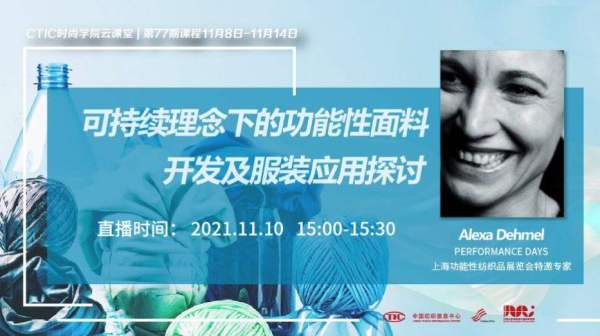
On November 10th, FUNCTIONALTEXTILESSHANGHAIBYPERFORMANCEDAYS Shanghai Functional Textile Exhibition joined hands with the "CTIC Fashion Academy Cloud Classroom" to share the "Discussion on Functional Fabric Development and Apparel Application under the Sustainable Concept". PERFORMANCE DAYS Shanghai Functional Textile Exhibition invited expert Alexa Dehmel to focus on sustainable fiber materials, multi-dimensional analysis of the green development era, global functional fabric development and recycling directions, and provide enterprises with innovative application solutions for the entire life cycle of textile products.

Alexa Dehmel has more than 30 years of extensive and in-depth expertise and high-level professional capabilities in the apparel industry, focusing on design and development, providing consulting and widely recognized for many well-known European brands. At the Shanghai International Functional Textile Exhibition, which will be held in the Shanghai World Trade Center Exhibition Hall on December 6-7, Alexa Dehmel will share with you the latest trends in clothing from European and American brands through the interpretation of the latest and different types of sustainable fabrics. Sustainable design and application concept.
Sustainability-driven process innovation, technological innovation and product innovation
"Mixed, degraded and recycled materials, there are many ways to make materials continue to use and extend the life cycle, but not every material can match these three methods." Alexa Dehmel said that companies should think about how to use materials before Recycling, thereby reducing unnecessary recycling procedures.
I:CO, a branch of I:COLLECT, a leading global solution provider, has a unique global recycling system in the textile industry, and has continuously collected clothing and shoes from more than 60 countries. "The recycling system improves resource utilization and economic benefits. Fashion stores and retailers collect clothes and shoes from customers. I:COLLECT assists in the logistics, sorting and transportation of these items to various recycling chains." Alexa Dehmel introduced, I:COLLECT Efforts are being made to make this process a closed loop to ensure the maximum value of reuse.
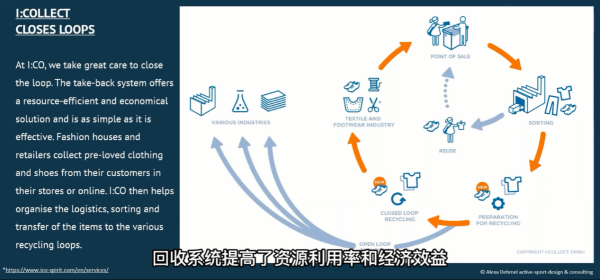
The automated recycling line of the SIPTEX project, Sweden's first fully automated fabric sorting program, can process waste materials at the front and rear ends. The front end includes waste from the fabric industry such as trim, yarn and defective products, and the back end is garments from various recycling centers. Or home fabrics. Accurately classify fabrics according to different types of fibers and colors through automated detection, thereby improving efficiency.
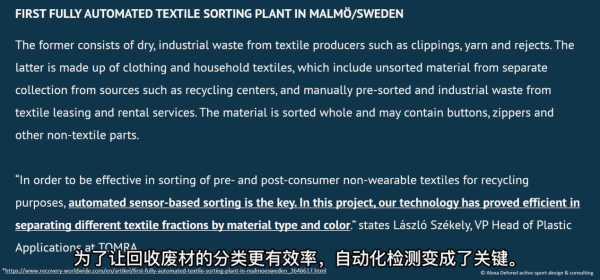
RE: Newcell separates stains and other non-fibrous materials by making clothes and fabrics with high fiber content into pulp. The pulp can be dried and processed into a pure and natural dissolving pulp from 100% recycled fabrics, that is, recycle Cellulose. Alexa Dehmel said that the use of recycled cellulose fibers to make clothing can significantly reduce the use and waste of water and land, while reducing plastic pollution, carbon dioxide and other chemical emissions, and helping brands fulfill their promise to reduce adverse effects.
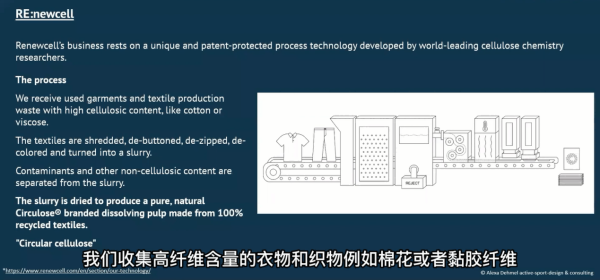
"According to the Higg MSI index, Recover fiber is one of the most sustainable cotton industry solutions today, promoting a closed-loop and truly sustainable fashion industry." Alexa Dehmel mentioned that RECOVER provides R-COOTON and R-COLORVBLEND. A series of low-quality recycled fiber products suitable for all fashion products, accessories and home furnishing industries.
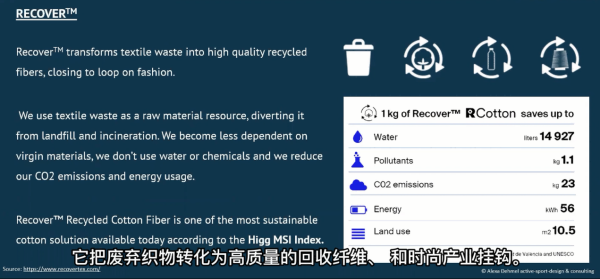
Recyclable and degradable become a competitive advantage
Alexa Dehmel took the innovative fabrics exhibited in the trend zone of the German Functional Textile Exhibition as an example. It has a good impact on sustainable polypropylene, recyclable nylon, recyclable polyester fiber, recyclable natural blends, bio-based nylon and polyester fibers, The characteristics and application directions of six types of environmentally friendly functional fibers of biodegradable nylon and polyester fibers are analyzed.
Sustainable polypropylene can be used for 2 and 3 layers of films, fabrics, webbing and zippers. Trenchant Textile and the world's leading polypropylene recycling company have jointly explored the process of using 100% polypropylene PP3 zipper series, seamless webbing and PP film fabric to make clothes, which proved that the production of clothes is produced through physical machinery and high-temperature pyrolysis of polypropylene. TT'sPP3's combination of surface accessories can help brands achieve recyclability of clothing made of completely recycled materials.
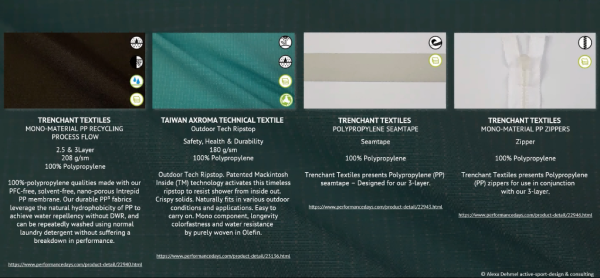
Recyclable nylon is suitable for 2-layer and 3-layer, such as the mixing of middle layer and heat-insulating nylon 6 with outer film and zippers. Recycled nylon can be made from waste nylon yarn, pre-consumer recycled yarn, pre-consumer waste, recycled raw materials, fishing nets, fiber waste, carpets, industrial plastics or used tires. Alexa Dehmel pointed out that recycled nylon is as soft as traditional nylon. The special structure makes the fabric elastic and can be completely recycled after consumption.
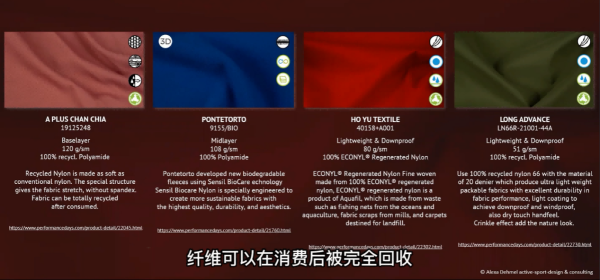
Recyclable polyester fiber can be applied to each layer. Recycled polyester fibers can be made from PET bottles, undersea plastic, marine plastic waste, recycled coffee grounds, household and commercial recycled plastics, polyester fiber waste, waste yarn and clothing, waste fibers, old fabrics, and industrial waste in the fabric chain become.
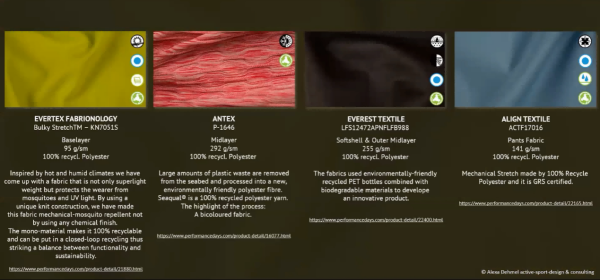
Naturally degradable and recyclable natural blends include cotton, hemp, kapok, linen, wool and other fiber categories. Among them, cotton has strong moisture absorption, wind resistance and air permeability; hemp fiber has natural antibacterial and thermal conductivity, light and thin, strong, UV resistance, natural hydrophobicity and other excellent characteristics; the special hollow tube type of kapok provides good Insulation layer, with natural hypoallergenic, antibacterial, anti-dust and other properties; Manila hemp, as one of the strongest natural fibers, can be antibacterial and thermal insulation, has good humidity control, natural UVA and UVB protection properties; flax fiber in Summer provides coolness, while being anti-odor, anti-allergic, anti-fungal and bacteria; wool can insulate the body well, while absorbing moisture and hydrophobic.
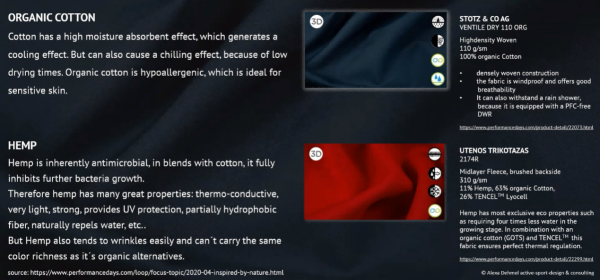
Bio-based nylon and polyester fibers are derived from starch, sugar, and oils separated from corn, sugar cane, sugar beet and vegetable oil. Bio-based can be used 100% or partly. "A lot of raw material options are placed at the conceptual level and are not used in commerce." Alexa Dehmel said that biosynthetic fibers have the potential to generate fewer greenhouse gases than fossil fuel products. The conversion into bio-based materials is very important for industry and society. benefit.
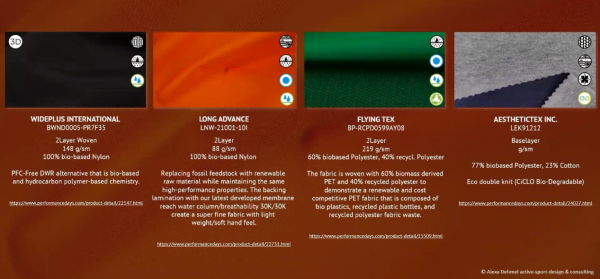
"A product can only be biodegraded when microorganisms can break it down into elements such as carbon, oxygen, hydrogen or other mineral factors. This means that in principle plastics made from fossil fuels can also be biodegradable." Alexa Dehmel said, For organics such as nylon and polyester fibers, if the material cannot be decomposed by itself, the product will be broken down into fragments. This process requires pressure, ultraviolet radiation, salt water, and a certain temperature.
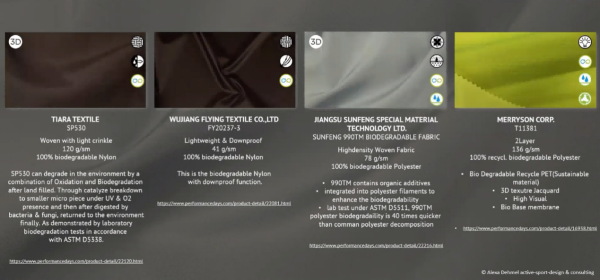
Under the guidance of the "dual-carbon" goal, promoting the green and low-carbon circular innovation of textile products from the entire life cycle of design, production, sales, use and recycling has become a key move for the global textile industry chain value chain upgrade. On December 6-7, the Shanghai International Functional Textile Exhibition will take "new materials, new fabrics, new trends" as the theme, and set up a sample display area for the fashion trend of sustainable functional surface materials on site, selected from 71 overseas companies 250 samples of fabrics and 150 accessories from top textile companies and hundreds of innovative samples submitted by exhibitors show the sustainable fashion charm of textile products in terms of design, material, technology, and application. The excellent fabric exhibitors and abundant products gathered at the exhibition will not only provide brand enterprises and buyers with diversified and diversified choices, but also build an efficient cooperation platform for in-depth exchanges between the upstream and downstream of the industrial chain.
Faux Leather Fabric,Faux Leather Material,Red Faux Leather Fabric,Faux Leather Stretch Fabric
zhe jiang royal textile technology co.,ltd. , https://www.royal-sofafabric.com
